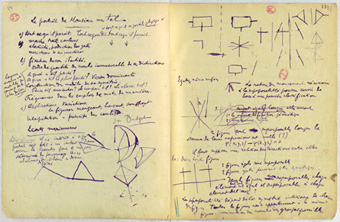
 The influence of the French author and poet Paul Valéry extends far beyond literature. His writings concern issues and discoveries in the arts and natural sciences and reflect on political developments and historical events. Valéry’s all-embracing curiosity and intellectual agility are most apparent, however, in the 261 notebooks that he left behind, the Cahiers, in which he ceaselessly fashioned new connections between the different spheres of knowledge. As one leafs through these notebooks one is astounded by the dense and varied interweaving of text fragments, drawings, and formulas. The writing is not ordered on the page in a purely sequential way but also all at once and with overlaps; it is distinguished by different »formats,« such as lists, philosophical or scientific aperçus, analytical passages, literary fragments, and comments on the drawings. Explanatory sketches alternate with associative, draftsmanlike designs and geometric diagrams. And amidst everything, there are quick doodles—stickmen, spirals, fields of lines.
The influence of the French author and poet Paul Valéry extends far beyond literature. His writings concern issues and discoveries in the arts and natural sciences and reflect on political developments and historical events. Valéry’s all-embracing curiosity and intellectual agility are most apparent, however, in the 261 notebooks that he left behind, the Cahiers, in which he ceaselessly fashioned new connections between the different spheres of knowledge. As one leafs through these notebooks one is astounded by the dense and varied interweaving of text fragments, drawings, and formulas. The writing is not ordered on the page in a purely sequential way but also all at once and with overlaps; it is distinguished by different »formats,« such as lists, philosophical or scientific aperçus, analytical passages, literary fragments, and comments on the drawings. Explanatory sketches alternate with associative, draftsmanlike designs and geometric diagrams. And amidst everything, there are quick doodles—stickmen, spirals, fields of lines.
Valéry’s notebooks reveal themselves again and again as a place for the appropriation of knowledge from mathematics and physics. The formulas and scientific drawings evince an imitation of and a self-immersion in conventions of thought and illustration from the sciences. But bit by bit what has been appropriated is transformed and becomes the expression of Valéry’s »own« practice, which is dedicated to the analysis of the mind. Valéry’s ways of working can only be understood in the context of his aesthetic, which must also be taken into account in the investigation of the scientific drawings in the Cahiers. While on the one hand Valéry’s writings aim at a rigid exercise in form, on the other they develop a processual aesthetic that erases the artwork’s material and temporal boundedness. What comes into the foreground here is the provisional character of the artwork, its status as a concrete fragment of the »inner life« of the artist. An aesthetic tied in such a way to mental and physical processes and an insistence on the »provisionality« of the work hereby ultimately undermines the historical interrelationship in the development of the arts and sciences. Indeed one finds in Valéry’s declarations about science a similar concentration on the process of producing ideas and a disregard for the results. The sciences too he traces back to open, »provisional« processes that are hardly classifiable. The consequences of this approach of Valéry’s are paradigmatically evident in the process of writing and drawing by which the Cahiers were produced. The notebooks are the site of an exploration of the mind’s capacities, both in practical-performative and theoretical terms: the Cahiers are constituted as records of a self-observation that documents and analyzes its own nervous cerebral oscillations.
The form and content of the Cahiers must be thought of together, on the basis of the considerations that I have outlined. Valéry dissolves the distinction between arts and sciences also in this sense: that no special relationship is admitted any longer between science and truth or factuality. Arts and sciences can have effects in the real world, but fundamentally the sciences for Valéry are artificial systems of rules: they are »languages,« conventions, and—in that sense—an aesthetic. To that extent Valéry can speak of the »style« of individual scientists and classify his Cahiers as belonging to the »genre« of science. The obviously polymorphous character of the Cahiers and the tension between art and science that is at their core are underlain and completed by a subtle net of formats and conventions that is to be investigated.
[PHOTOGRAPHY/COPYRIGHT CREDITS]
Paul Valéry: Journal de bord. Bibliothèque Nationale de France. © Martine Boivin-Champeaux